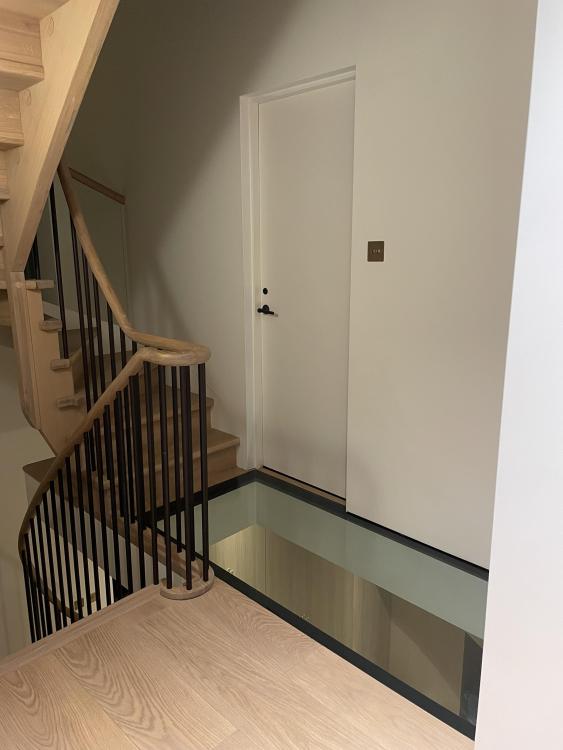Leaderboard
Popular Content
Showing content with the highest reputation on 04/11/24 in all areas
-
Welcome. When I bought my first place, the first room I worked on cost a fortune, mainly from buying tools and other kit. The next room cost a lot less, third even less. Called a convergent series in mathematics. An infinite number of mathematicians (thinking of you @Garald) went into a bar. The first one bought a pint if beer, the second one half a pint, third one a quarter pint, the fourth one an eighth of a pint. The barman pulled two pints and said 'you lot need to learn your limits'. Just get on and do things in an intuitive manner, learn from mistakes, and lost fingernails, but if you get really stuck, ask and get 20 right answers.2 points
-
There is just no way you should agree to have obscured glass installed in your house to protect the amenity of their development. It may really impact on the value of your property.2 points
-
I'd be cautious with the unit you buy as those optimised only for cooling may not work efficiently when heating. I bought a Daikin FTXM25R. I will update IF I EVER MANAGE TO GETTING AROUND INSTALLING IT.2 points
-
Probably not enough, You need 2x windows open to get a decent cross flow. The trouble is then that the house gets cold and they get closed. This needs to be on 24/7 a max power. Take this out and replace with one of these. As mentioned above, it runs continuously and ramps up when the humidity does. and sucks out all the damp air. Costs about 1/20th of what a dehumidifier does to run.2 points
-
Hello peeps, Owner (mortgaged to the eyeballs) of a 70s link detached house in North wales. House seemed perfect on viewing but constantly finding issues. Im starting to build up quite the tool collection, I just lack the experience and expertise to use them well. Always ready to get the experts in when needed but hate the thought of getting someone to do something I could learn to do myself with a little effort. So far I've fitted 2 toilet door locks (mortice) and I now have even more respect for carpenters and fitters but I give me 3+ hours and I can it myself now! As much as I enjoy a bit of DIY, ultimately cash is a major factor in why I'll be doing as much as possible myself. I hope to find a happy home in this forum. See you online Dan1 point
-
We have 1 set of inward opening Alitherm Heritage french doors which leak like this when the rain is being blown by the wind in the right direction. The doors drainage system gets overwhelmed. I used a hose pipe to test my theory. It is on my todo list to sort out. Luckily the rain usually comes from a different direction. I am hoping I can beef up the seals with a larger gasket. I might also drill two more drain holes.1 point
-
Double decker for twin and earth, triple decker for anything taking 3-core and earth e.g. blinds with 2 switched lives for up/down drive1 point
-
Thanks for the replies. So I've concluded that this purchase is dead in the water. The only option that is viable, is for them to ask the land owner behind them if they can site a new drainage field for their property under the horse paddock so it's adequate distance away. I have a feeling that they will instead just try and find an unsuspecting buyer who doesn't ask as many questions as we have. In the grand scheme of things, I personally would be happy to spend 15k for said drainage field if I was set to gain 350k from selling part of my garden.1 point
-
Not my house but I installed a PS+B for someone else. I went with Yuasa REC36-12 36Ah1 point
-
Afaik you can use whatever you want to use! I used the one you posted as I terminated every T&E on the side with 3 levels as the earths all commoned on the din rail. @Rob99 uses double decker TB for L & N and terminates the earths on a connection bar. Horses for courses from my perspective. my sparks was happy with the way I’d done it. there are only 2 levels on the “internal” side as there’s no earth from the relays so it’s just the switched live and commoned neutral from the RCBO1 point
-
Yes. Drainage fields have a high chance of failing so what then. If it’s a treatment plant into a soakaway then it’s less of a problem as the effluent is mostly clear water but that’s assuming it’s all well maintained but I still wouldn’t want it that close. As a general point I wouldn’t want someone else’s services like this on my land just like I wouldn’t want mine on someone else’s land.1 point
-
Speaking from experience, the initial DNO quote isn’t always the final cost. In my case, I was quoted around £15k to begin with. Some careful research and negotiation with the DNO saved me £14k - we paid about £960 in the end.1 point
-
1 point
-
You are asking for comments on the TF, but may I ask about the floor? What U value do you get with 100mm PIR? Could you fit 150 in (or even greater thickness and use graphite EPS instead of PIR)? Will you have under-floor heating? If so others will be along to highlight the greater delta T (and therefore the justification for more insulation).1 point
-
Epoxy, or CT1, which my former colleague claims will stick more-or-less anything to anything! I don't know anything about Soudal Plasterboard Adhesive but wonder if an adhesive made for a dry indoor environment would do well in a wet outside one... (Happy to be proved too sceptical)1 point
-
1 point
-
@minty Are you any good at playing with wires and computers. For a few quid you can make a multiple sensor temperature and RH data logger. They come in handy all the time. Thinking about the damp more, it is worth remembering that it takes quite a lot of energy to evaporate liquid water. Liquid water takes 4.18 kJ/kg.K, to get from liquid to vapour (phase change) takes 2256 kJ/kg. That is 540 times more energy. So sometimes drying a place out is much harder than you think.1 point
-
It is a bit difficult to track internal relative humidity (RHI) and the contribution from the outside air relative humidity (RHO) sometimes. I suspect you have a leak somewhere, finding it may prove to be hard as liquid water can travel quite a distance from the entry point. Is there any sign, inside or outside that water is leaking out i.e. a damp carpet, a stain in the bathroom, an odd dripping noise (water meters really help here), staining on the outside cladding. Worth having a very good look around the windows, especially if they are replacement ones. The vapour control layer (VLC) may have been damaged. I seem to remember that a person expires 2 litres a day, not a lot in a big building but quite a bit in a small one.1 point
-
Your builder should be painting the ceiling before the kitchen goes in, trying to paint around it is just stupid, it will need 3 coats, a diluted mist coat and 2 top coats, mist coat the walls as well.1 point
-
Here’s a reasonable article that might help. Every day living produces quite a lot of water vapour in a typical house (20 litres for a family of four according to this article). Your mum’s small poorly ventilated house with plastic in the walls will keep a lot of this water vapour trapped in the building. https://www.cityoflondon.gov.uk/assets/Services-DCCS/condensation-booklet.pdf1 point
-
I would get them to document the offer and as long as it is clear, is completely in line with what you have agreed, and not full of weasel words (ie a bunch of provisos) and signed, then I would go with it. This is a clear agreement from them, and I doubt it would be worth fighting it in court if they reneged anyway.1 point
-
The choice of heating system doesn't really affect the humidity (assuming you're not using some sort of open flame gas heater, which will spew out moisture). But the advantage of ASHP, of whichever type, is that they convert one unit of electricity in to three or four units of heat, so compared to basic electric heating you can have the house much warmer. Anything you can do to raise the temperature will help. In theory the air movement of A2A might help eliminate dead spots where damp air can linger. But if you under-spec the A2A you can end up with high airflow rates which will lead to noise and drafts. I'm in the process of planning an A2A install myself but can't report back any actual feedback yet...1 point
-
just to hide the holes in the floor, if you cant remove that bit of flooring then i guess your options are limited. I dont think there is a way to check where the flow diverter is without a drain down. I wouldnt worry if the rad is heating up to your liking.1 point
-
Solicitor at their cost. Put your objection in, with a caveat saying it will be removed if the developer can agree a legally binding undertaking1 point
-
Don't seal! Paint with watered down non-vinyl emulsion e.g. contract matt or specific paint for new plaster. MacPherson Eclipse is a good start1 point
-
Great. If you accept that they are expected to make a reasonable profit, it's a good start. Then what can we do as a team,and within that, to make savings/ keep to budget? Huge, substantial, reasonable? Define the risk areas.1 point
-
Agree with the comments above. I am sure there's more to the process so far than I read, but it sounds like *you* have come up with a compromise so that *they* can get PP. Not sure where the 'balance of power' is there, and agree with others that you should at least look at the issue of future sale now, before development, whatever the 'inducements', even if your ultimate conclusion that it will sell with no probs. It sound like not a fun position to be in - literally - and I wish you luck with the outcome.1 point
-
You don’t want to seal over fresh plaster because it needs to dry out. Once dry, if you are painting it then the mist coat acts like a primer to get hold of the plaster surface, not to seal it.1 point
-
+1 why put your self out unless there is a significant benefit for you.1 point
-
Sounds like a good deal for the developer then, to get over some hurdles - will they at least also cover your legal expenses? Are they also going to insist on a covenant to prevent you switching windows back to plain glass? (I'm not 100% clear if the problem is you'll overlook the neighbour, vice-versa or both) Legals aside, have you considered how this deal might affect any future buyer if you ever come to sell? It sounds like you're losing being able to see out of three bedroom windows (presumably others still have a clear outlook?) in return for a discounted patio (say 2-3k saving)? That's not a lot if it puts off future buyer. It sounds like the developer is pretty keen that you don't object - unless there's other sums involved I wouldn't be too swayed by the discounted patio for something that affects your future enjoyment or price if you sell.1 point
-
It needs to be dry which can take a while. I left mine two weeks before applying a mist coat which is just watered down emulsion although I actually used Valspar Express Coat rather than watered down emulsion. You can buy new plaster sealer but it’s quite dear so it depends on what area you are covering. Leave it for 24 hours after the mist coat before applying the next coat. There was one wall I was impatient to get on with and it’s been a pain in the arse so do it right and you’ll be fine. I’m still trying to fix that one wall!1 point
-
I did a large extension job that needed piling, there was a known sewer 6M deep running across the plot, United Utilities would not take the liability for plotting its location. So the customer organised a camera inspection and location, this was marked out, pile layout was designed around the pipe location........ Build over agreement in place. The piling contractor (thankfully working for the client and not me) piled as per the plan and caught the edge or the 600mm dia pipe @6M deep, thankfully not crushing the pipe but putting a lovely core into the edge of it. When every man and his dog from United utilities turned up, the area supervisor said "that pipe follows this line" - pointing down the road, "see that tree 5 houses down, there's an inspection chamber next to it". absolutely nowhere near the marked location. i.e. about 5M out of line. Camera company said "not our fault, there is a tolerance of error." Anyway, the above is a warning to not bet your shirt on this service.1 point
-
The danger is it just gets passed anyway and you get nothing out of it. The development is going to happen one way or another. While Ian is right about not being rushed don’t slow walk it either. The sooner they start the sooner it will be finished. After all you’ll be living next to a building site for a long time.1 point
-
Don't be rushed, put the onus on the builder to put the legal document in place at their cost, and to cover your legal costs. It can't be done in the timeframe of the current planning app so either suggest to them them to withdraw their application and resubmit when everything is agreed, or continue with your objection until the agreement is in place.1 point
-
A few hundred pounds at most and a solicitor will do it for you. It would then be a notarised legal document signed by you and the developer. One important thing is timescales when you want it done by. I’d have a date in the document. Otherwise they might leave it until the very end of the development. Also a legal document shows intent rather than something you’ve knocked together yourself.1 point
-
1 point
-
You can't get away from the world electrifying either. As a general note, the heat losses for the same building will be the same regardless of the thermal source. You size your heating system to your building, not the other way around.1 point
-
No, pipework wasn't there and I had to get to work so I stupidly made an assumption that he would center it. I know better now to spell out my expectations! Anyway I've changed it after much careful jiggery poker.1 point
-
If everything is cost+, what is your builders incentive to complete the project as quickly as is feasible? How about chasing sub-contractors; why should builder worry about managing/chasing/replacing sub-contractors (e.g. electrician) if the project taking longer doesn't impact him? Surely there is a risk that things just drag on and on?1 point
-
I'd go dmev, not PIV. PIV pulls fresh air in, which is good, but it's pushing the humid air out via gaps and holes in brickwork, around frames etc. Forcing damp air through the building fabric doesn't sound a great idea1 point
-
47x42mm is what I've used. You can nailgun them then, if that's any use to you. Also 50mm mineral wool insulation is readily available, I wouldn't object to wider mind you.1 point
-
At various points in my career (at some points prior to getting degree), I managed and mentored nearly qualified and also Chartered or nearly Chartered Engineers, most had no clue how to move high level learning into real life situations. They could speak at great lengths about NPSH (net pressure suction head) for pumps, but would walk straight past a pump on a plant as they had never seen or touched one. They think they are Engineers because they are allowed to be Chartered, but really shouldn't be allowed to be chartered for another decade. There is a lot to be said about starting at the bottom and moving up the ladder, with suitable learning on the way.1 point
-
These values would not pass Scotland new build target. Max wall is 0.15 - I think you need to push for better levels of insulation, this will reduce your heating requirements further making GSHP illogical. IMHO You need to advise your experts, that you want to achieve push for passive house levels of insulation and Airtightness, without the associated costs of Passive house. I was on a tight budget, but planned to better max U values, and achieve 1 or less ACH. You only get one chance to get this bit correct. I managed my goals and budget with tweaking the design and flexibility with material selection.1 point
-
I think we've developed too much of a bias about degrees and the value they actually bring. I've met plenty of non-degree, non-formally trained engineers that will blow the socks of many engineering degree holders in both theoretical and practical knowledge. I also think we've developed a problematic prejudice towards manual work versus the degree holder. I hold a Master's degree, I studied aerospace engineering at degree level (but changed course during the degree as I got bored with the extent of mathematical modelling in front of computers) and then also studied acoustics, thermodynamics and fluid dynamics during a period where I designed exhaust systems. Now I am a heating 'engineer' installing heating systems, gas boilers, doing reparis and servicing part time - I actually find quite a lot of it very rewarding. Now, with all that being said, I do have an issue with the level of training and certification in the heating industry - I think it's appalling. But the problem with that is that is turns from protect to protectionism which becomes counterproductive. There would need to be some careful definition of what engineer actually meant and recognise various routes that can be taken to achieve this. Am I an engineer if I can take a lump of metal and form it to become a useful component part of a machine, whether as repair or new design, or am I an engineer only if I can sit in front of a cad/cam and produce design drawings along with some calculations?1 point
-
Yes, an extractor to the outside. It's through a gravity flap which has a rubber seal on and is pretty airtight, certainly not entertaining any backflow. It will very rarely (depending on wind direction) flap open briefly on very heavy gusts and so I've considered going to a motorised damper, but it's just not bad enough to really worry about...1 point
-
Bog-standard (but powerful) extractor, and MVHR extract point over the sink but near the cooker. Normal steamy cooking is dealt with just fine by the MVHR, but on the occasions that I want to fry or stirfry I whack on the big fan. Ensures the oils aren't heading into the ducts, and I really don't care if flow is unbalanced for half an hour every now and then...1 point
-
1 point
-
1 point
-
I'm interested in this comment. One ashp installer I am talking to suggests a pump plus phe instead of a large coil in the cylinder. The cost is no different because it allows you to use a cylinder that doesn't have a coil (£400) as opposed to a heat pump specific cylinder (800+). The arguments for the arrangement seem potentially convincing to me, although there is the noise of the pump to consider. It also introduces the possibility to put the pump plus phe remote from the cylinder, or retrofit an existing cylinder which has an insufficiently large coil, both of which have applications.1 point
-
We started with a combi boiler, driving UFH, thought nice, easy, cost effective. But getting a big gas boiler to work well in a low energy house isn't easy. They just short cycle, using way more gas than they should. Eventually got it working well. But swopped it last year for an ASHP, all self funded. Doing it again, ASHP every time, 3m2 coil UVC for hot water. House heated as a single zone. Three ways to heat Fan coils not the cheapest option, but good for cooling and heating Big radiators run on weather compensation or UFH on the ground floor and any upstairs bathrooms. Add provision for electric panel heaters in bedrooms, just in case you need them. If doing UFH do a 100mm thick screed and charge on a cheap tariff the same as a storage heater, or thin screed and run on weather compensation. MCS grant scheme should be the cheapest, but just seems a rip off get quick scheme for installers. From everything I've seen Panasonic ASHP seems very good, something like a 200L cylinder, and heat emitters is all you need. £4-5k all in, plus install, and there is nothing complicated. Insulation and ventilation will have an impact on heat source sizing. Best advice I have seen. We have done many kitchens in many houses, back in 1999 we spent 25k on a kitchen, latest one in 2022 was about £7k and way nicer.1 point




















